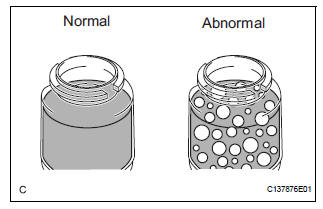Toyota Sienna Service Manual: Power steering fluid
Bleeding
1. BLEED POWER STEERING SYSTEM
(a) Check the fluid level (See page PS-2).
(b) Jack up the front of the vehicle and support it with stands.
(c) Turn the steering wheel.
(1) With the engine stopped, turn the steering wheel slowly from lock to lock several times.
(d) Lower the vehicle.
(e) Start the engine.
(1) Run the engine at idle for a few minutes.
(f) Turn the steering wheel.
(1) With the engine idling, turn the steering wheel left or right to the full lock position and keep it in that position for 2 to 3 seconds, then turn the steering wheel to the opposite full lock position and keep it there for 2 to 3 seconds.
(2) Repeat this procedure several times.
(g) Stop the engine.
(h) Check for foaming or emulsification.

HINT: If the system has to be bled twice because of forming or emulsification, be sure to check for fluid leaks in the system.
(i) Check the fluid level (See page PS-2).
 On-vehicle inspection
On-vehicle inspection
1. INSPECT DRIVE BELT
(a) Visually check the drive belt for excessive wear,
frayed cords, etc.
If any defect is found, replace the drive belt.
HINT:
Cracks on the rib side of a belt are con ...
 Vane pump
Vane pump
COMPONENTS
...
Other materials:
Hitch
Trailer hitch assemblies have different weight capacities. Toyota recommends
the use of Toyota hitch/bracket for your vehicle. For details,
contact your Toyota dealer.
If you wish to install a trailer hitch, contact your Toyota
dealer.
Use only a hitch that conforms to the gross trailer w ...
Brake control
Sst
Recommended tools
HINT:
Torx is a registered trademark of Textron Inc.
EQUIPMENT
LUBRICANT
BRAKE
SST
RECOMMENDED TOOLS
EQUIPMENT
LUBRICANT
PARKING BRAKE
EQUIPMENT
STEERING COLUMN
SST
EQUIPMENT
...
Problem symptoms table
HINT:
Proceed to troubleshooting of each circuit in the table below.
1. HEADLIGHT AND TAIL LIGHT SYSTEM
2. AUTOMATIC LIGHT CONTROL SYSTEM
3. LIGHT AUTO TURN OFF SYSTEM
4. FOG LIGHT SYSTEM
5. TURN SIGNAL AND HAZARD WARNING SYSTEM
6. ILLUMINATED ENTRY SYSTEM
7. OTHE ...
